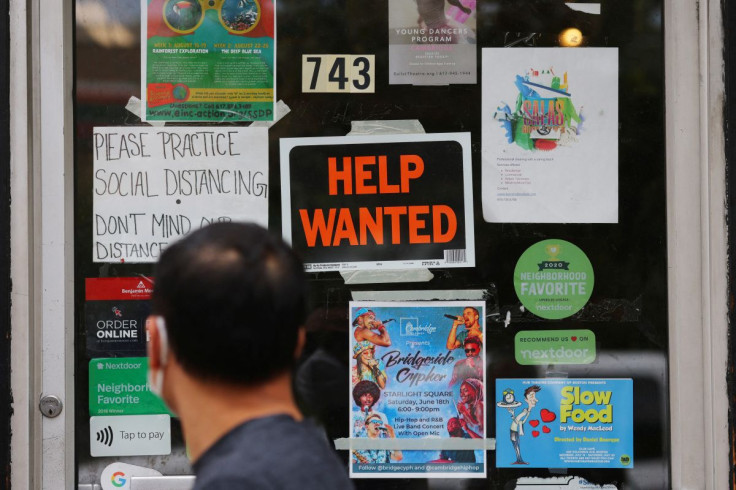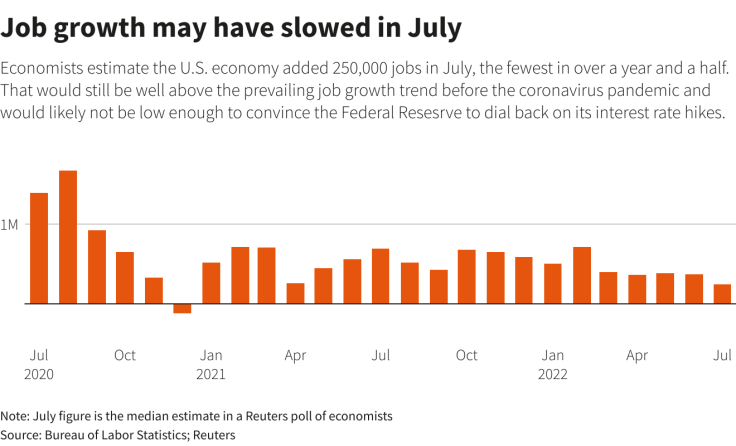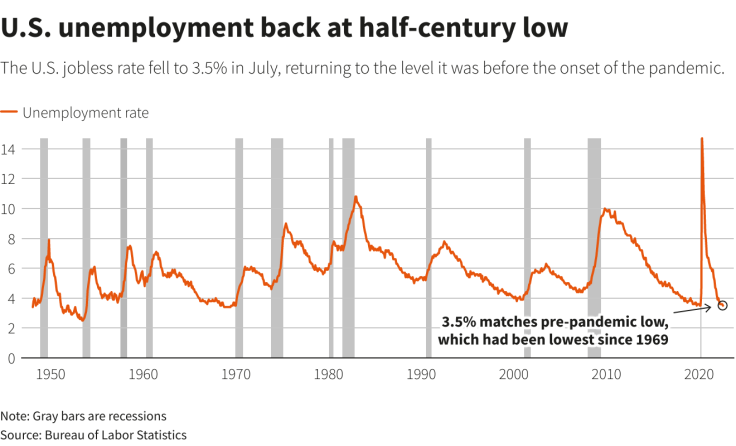U.S. Job Growth Seen Slowing In July; But Far From Recession Levels

U.S. job growth likely slowed in July, but the pace was probably strong enough to keep the unemployment rate at 3.6% for a fifth straight month, offering the strongest evidence yet that the economy was not in recession.
The Labor Department's closely watched employment report on Friday is expected to paint a picture of an economy muddling through despite back-to-back quarters of contraction in gross domestic product, the broadest measure of U.S. economic activity. Though demand for labor has eased in sectors like housing and retail that are sensitive to the higher interest rates being engineered by the Federal Reserve in its battle against inflation, industries like airlines and restaurants cannot find enough workers.
"The labor market is no longer tinder box hot," said Sung Won Sohn, professor of finance and economics at Loyola Marymount University in Los Angeles. "But it remains pretty healthy and does not meet the National Bureau of Economic Research's broad definition of a contraction in the economy."
The NBER, the official arbiter of recessions in the United States defines a recession as "a significant decline in economic activity spread across the economy, lasting more than a few months, normally visible in production, employment, real income, and other indicators."
Still, government data last week showing a second straight quarter of negative GDP - which meets a popular rule-of-thumb definition for recessions - has fanned widespread debate over whether the U.S. economy is in fact in a downturn and has brought the employment report for July into even sharper relief for consumers, investors and policymakers.
Job growth may have slowed in July:

Nonfarm payrolls likely increased by 250,000 jobs last month after rising by 372,000 in June, according to a Reuters survey of economists. That would mark the 19th straight month of payrolls expansion but would be the smallest increase in that span and below the first half monthly average of 457,000 jobs. Estimates ranged from as low as 75,000 to as high 325,000.
The cooling in job growth could ease pressure on the Fed to deliver a third straight three-quarters of a percentage point interest rate increase at its next meeting in September, though much depends on inflation and employment readings in the run up to that gathering.
The U.S. central bank last week raised its policy rate by 75 basis points and officials have pledged more hikes are coming as it tries to rein in inflation running at four-decade highs. Since March, it has lifted rates from near zero to their current range of 2.25% to 2.50%.
"A slowdown in job growth should be welcome news for Fed officials, but a more material loosening of labor market conditions will be needed to take the heat off wage inflation," said Lydia Boussour, lead U.S. economist at Oxford Economics in New York.
The economy contracted 1.3% in the first half of 2022, largely because of big swings in inventories and the trade deficit tied to snarled global supply chains. Still, momentum has cooled.
Hours worked, levels of temporary workers and the breadth of job growth will be closely watched for clues on how soon the anticipated recession might begin. The average workweek has been hovering at 34.5 hours.
BROAD SLOWDOWN
The moderation in hiring was likely across the board last month. But government employment, which remained in the hole by 664,000 jobs in June, is a wild card as state and local government education has not followed typical seasonal patterns because of COVID-19 disruptions.
This could throw off the model that the government uses to strip seasonal fluctuations from the data.
"Normally, July state and local government education employment falls by 1 million," said Ryan Sweet, a senior economist at Moody's Analytics in West Chester, Pennsylvania. "This may not have occurred this year, and a smaller than normal decline will cause the seasonal adjustment factors to inflate the adjusted data."
U.S. unemployment seen near 50-year low in July:

Economists are also eyeballing a possible drop in retail employment. High inflation - last measured at 9.1% year-on-year in June's Consumer Price Index - is forcing Americans to spend more on low-margin food products instead of apparel and other general merchandise, leaving retailers like Walmart Inc carrying excess inventory and issuing profit warnings.
But the rising cost of living and fears of a recession are forcing some retirees and others who had left the labor market to search for work. That has increased the supply of workers somewhat, keeping the unemployment rate steady near its pre-pandemic lows. Given 10.7 million job openings at the end of June and 1.8 openings for every unemployed person, economists do not expect a sharp deceleration in payrolls growth this year.
With the labor market still tight, average hourly earnings are forecast rising 0.3%, matching June's gain. That would lower the year-on-year increase to 4.9% - the lowest since December - from 5.1% in June. Though wage growth appears to have peaked, pressures remain.
Data last week showed annual wage growth in the second quarter was the fastest since 2001.
Economists will also keep an eye on employment levels reported in the report's more-volatile household survey, which had dropped by 315,000 jobs in June. The number of people working part time for economic reasons, will also be under scrutiny after plunging to the lowest since 2001 in June.
© Copyright Thomson Reuters 2024. All rights reserved.





















